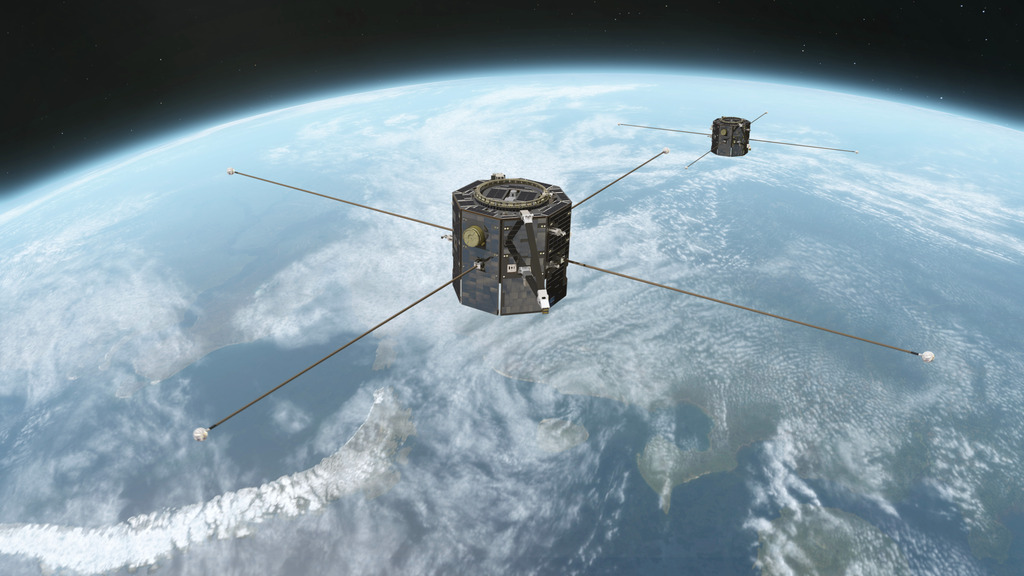Quickshot: New NASA Mission Launching Soon To Study Earth’s Space Weather Shield

Scroll down page for advisory with suggested questions and anchor intro. You will also find the associated cut b-roll and pre-recorded soundbites below.
Click here for more information about TRACERS
Quick summary:
- NASA’s twin TRACERS (Tandem Reconnection and Cusp Electrodynamics Reconnaissance Satellites) satellites will help answer fundamental questions about how space weather impacts Earth’s magnetic field – information that is critical to accurately monitoring, and eventually predicting, the effects that space weather can have on astronauts, satellites, and even our technology on the ground.
- TRACERS will study Earth's polar cusps, regions where the magnetic field allows solar particles into the upper atmosphere.
- TRACERS will enhance our understanding of "magnetic reconnection” when magnetic field lines from the Sun and the Earth explosively break apart and reconnect, by measuring it 3,000+ times in the first year of its mission.
- TRACERS is slated to launch this summer from Vandenberg Space Force Base in California.
Pre-recorded SOTs Details, background information + interview requests:
- To request an interview please reach out to: Sarah Frazier sarah.frazier@nasa.gov
- Limited interviews are available
- For more information check out:https://science.nasa.gov/mission/tracersand @NASASolarSystem on social media platforms
NASA’s newest heliophysics mission TRACERS (Tandem Reconnection and Cusp Electrodynamics Reconnaissance Satellites) will uncover the mysterious processes behind geomagnetic storms that have swept the globe with dazzling light shows called auroras or northern and southern lights. Though auroras are a crowd favorite to view, they are the result of electrically-charged particles hitting Earth that can also negatively affect power grids, satellites, and even astronauts in space.
Our Sun has been super active as it reached the peak of its 11-year solar cycle. That in turn has ramped up extreme space weather events in the form of geomagnetic storms and auroras. These events arise from solar eruptions and a steady stream of charged particles ejected from the Sun, called solar wind. Like a knight using a shield for protection, Earth’s magnetic field shields us from the brunt of those solar particles, but not all of them. When these particles and magnetic fields from the Sun meet Earth’s volatile magnetic field, the magnetic field lines snap and reconnect, creating new field lines and sending highly-energized particles in new directions including down toward Earth. TRACERS will aim to understand this exact phenomenon known as magnetic reconnection.
TRACERS will be the first ever mission to closely examine the polar cusp region repetitively and from space, to understand magnetic reconnection where the effects of this phenomenon are felt. The twin spacecraft will fly one after another allowing scientists to see the evolution of these explosive interactions and how they travel and change shape.
TRACERS will work alongside other NASA missions studying the Sun including PUNCH and EZIE, which launched earlier this year. Together these missions will provide a more complete picture of the Earth-Sun connection. TRACERS is also part of a larger initiative, NASA’s Explorers Program, studying how the Sun affects space and the space environment around planets.
Suggested Anchor Intro:
Lately, the Sun has truly been a superstar dazzling us with a surge of aurora displays across the globe as it hit the peak of its 11-year solar cycle. But the show isn’t over! NASA is gearing up to launch a new mission, TRACERS, that will take a deep dive into the dynamic region where the solar wind interacts with Earth’s magnetic field.
Here to tell us more is XX.
Suggested Questions:
1. NASA is getting ready to launch a new mission to study how space weather impacts Earth. Can you explain what space weather is?
2. We have had several geomagnetic storms and beautiful auroras in the past year across the globe, especially last May. Can you explain how TRACERS will study these storms?
3. We keep hearing about magnetic reconnection and the charged particles that hit Earth. Can you help us visualize what's actually happening when these magnetic field lines snap and reconnect?
4. TRACERS has two small satellites flying in tandem. Why was this mission designed to have two spacecraft instead of just one?
5. Why is understanding space weather important for protecting our astronauts as well as technology in space and on the ground?
6. Where can our viewers learn more?
Other questions:
7. What other things can space weather events impact?
8. What makes TRACERS different from the other missions that study the Sun?
9. How will the data from TRACERS help us improve space weather forecasts?
NASA & University of Iowa Interview Opportunity: NASA’S Newest Launch Set to Explore the Frontiers of Space Weather
BROLL PACKAGE
Pre-recorded interview with Reinhard Friedel [prounounced Free dill]/ TRACERS Program Scientist / NASA Headquarters. TRT 7:50. Full transcript is available under the download button. SOTS are separated by a slate with the associated question. SOTs answer the following questions:
1. NASA is getting ready to launch a new mission to study how space weather impacts Earth. Can you explain what space weather is?
2. We have had several geomagnetic storms and beautiful auroras in the past year across the globe, especially last May. Can you explain how TRACERS will study these storms?
3. We keep hearing about magnetic reconnection and the charged particles that hit Earth. Can you help us visualize what's actually happening when these magnetic field lines snap and reconnect?
4. TRACERS has two small satellites flying in tandem. Why was this mission designed to have two spacecraft instead of just one?
5. Why is understanding space weather important for protecting our astronauts as well as technology in space and on the ground?
6. Where can our viewers learn more?
7. What other things can space weather events impact?
8. What are you most excited about with this mission?
9. What makes TRACERS different from the other missions that study the Sun?
10. How will the data from TRACERS help us improve space weather forecasts?
Pre-recorded interview with David Miles / TRACERS Principal Investigator University of Iowa. TRT 6:04. Full transcript is available under the download button. SOTS are separated by a slate with the associated question. SOTs answer the following questions:
1. NASA is getting ready to launch a new mission to study how space weather impacts Earth. Can you explain what space weather is?
2. We have had several geomagnetic storms and beautiful auroras in the past year across the globe, especially last May. Can you explain how TRACERS will study these storms?
3. We keep hearing about magnetic reconnection and the charged particles that hit Earth. Can you help us visualize what's actually happening when these magnetic field lines snap and reconnect? (answer #1 and answer #2)
4. TRACERS has two small satellites flying in tandem. Why was this mission designed to have two spacecraft instead of just one? (answer #1 and answer #2)
5. Why is understanding space weather important for protecting our astronauts as well as technology in space and on the ground?
6. Where can our viewers learn more?
7. What makes TRACERS different from the other missions that study the Sun?
8. How will the data from TRACERS help us improve space weather forecasts?
9. What are you most excited about with this mission?
For More Information
Credits
Please give credit for this item to:
NASA's Goddard Space Flight Center
-
Producers
- Lacey Young (eMITS)
- Angel Kumari (NASA/GSFC)
- Michelle Handleman (eMITS)
-
Editor
- Lacey Young (eMITS)
Series
This page can be found in the following series:Release date
This page was originally published on Thursday, July 17, 2025.
This page was last updated on Wednesday, July 16, 2025 at 2:34 PM EDT.
![Produced VideoWatch this video on the NASA Goddard YouTube channel.Complete transcript available.Music Credit: "Praxis I,” “Three Voices,” and “Die Vogel” by Alexis Francois Georges Delong [SACEM], “Anticipation” by Nicholas Smith [PRS], “Ocean Wisdom” by Hugo Dubery and Philippe Galtier [SACEM], and “Call from the Sea” by MACARON [SACEM] from Universal Production MusicAdditional Video and Animations: University of Iowa, Southwest Research Institute, Millennium Space Systems, Andøya Space / Trond AbrahamsenSound Effects: Pixabay](/vis/a010000/a014800/a014862/14862_TRACERSoverview_Thumbnail.jpg)


